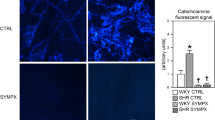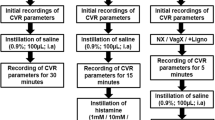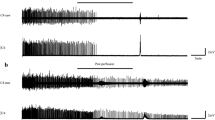Abstract
ANTISYMPATHOMIMETIC drugs have been shown to interfere with the inactivation of the sympathetic transmitter substance. Brown and Gillespie reported that the amount of noradrenaline appearing in the splenic venous blood following sympathetic stimulation at frequencies below 30/sec. is increased by phenoxybenzamine or dibenamine, and these authors concluded that the mechanism for the destruction of noradrenaline at the nerve endings is linked to the receptor for this substance and can be inactivated with them1. Brown, Davies and Gillespie found that large amounts of noradrenaline appear in the venous blood from both colon and small intestine if the sympathetic nerves were stimulated following the administration of phenoxybenzamine2. Millar et al. showed that phenoxybenzamine enhances the rise in plasma noradrenaline during hæmorrhagic hypotension in adrenalectomized dogs3. Benfey et al. found that the urinary excretion of noradrenaline following ganglionic stimulation by acetyl-choline is increased by phenoxybenzamine4. Hukovic showed that phenoxybenzamine augments the response to stimulation of the atrium of the heart isolated with its sympathetic nerves5. Benfey et al. reported that phenoxybenzamine elevates the urinary recovery of infused noradrenaline6. Martin et al. found that chlorpromazine can enhance and prolong the vasoconstrictor and chronotropic actions of adrenaline and noradrenaline7.
This is a preview of subscription content, access via your institution
Access options
Subscribe to this journal
Receive 51 print issues and online access
$199.00 per year
only $3.90 per issue
Buy this article
- Purchase on Springer Link
- Instant access to full article PDF
Prices may be subject to local taxes which are calculated during checkout
Similar content being viewed by others
References
Brown, G. L., and Gillespie, J. S., J. Physiol., 138, 81 (1957).
Brown, G. L., Davies, B. N., and Gillespie, J. S., J. Physiol., 143, 41 (1958).
Millar, R. A., Keener, E. B., and Benfey, B. G., Brit. J. Pharmacol., 14, 9 (1959).
Benfey, B. G., Ledoux, G., and Melville, K. I., Brit. J. Pharmacol., 14, 142 (1959).
Hukovic, S., Brit. J. Pharmacol., 14, 372 (1959).
Benfey, B. G., Ledoux, G., and Segal, M., Brit. J. Pharmacol., 14, 380 (1959).
Martin, W. R., Riehl, J. L., and Unna, K. R., J. Pharmacol. Exp. Therap., 130, 37 (1960).
Benfey, B. G., Brit. J. Pharmacol. (in the press).
Author information
Authors and Affiliations
Rights and permissions
About this article
Cite this article
BENFEY, B., VARMA, D. Stimulation of the Heart of the Spinal Dog by Phenoxybenzamine. Nature 191, 919–920 (1961). https://doi.org/10.1038/191919a0
Issue Date:
DOI: https://doi.org/10.1038/191919a0
Comments
By submitting a comment you agree to abide by our Terms and Community Guidelines. If you find something abusive or that does not comply with our terms or guidelines please flag it as inappropriate.



